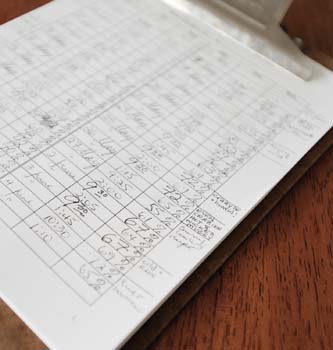To use your hygrometer:
- Hold the board at one end.
- Swing the hygrometer gently from side to side for two to three minutes.
- Note the temperatures on both of the thermometers. Pay attention to which is the wet reading (the reading from the thermometer with the damp cotton) and which is the dry reading.
- Use the Relative Humidity Table to calculate Relative Humidity (RH%) using the readings from your two thermometers.
- Keep track of your readings using the Relative Humidity Tracking Chart in Extras and Links.
Select locations and times when you will take readings. Morning and afternoon are generally sufficient, but feel free to take as many readings as you feel suits your situation. Redampen the cotton before each time you use the hygrometer.
 Over time, you may notice Relative Humidity levels within your library changing with the weather. Some locations in your library may be more humid than others. Mold can pull moisture out of the air, so extremely humid environments can support mold growth even if a collection has not experienced moisture damage. Ideally, your library climate should be about 40-50% Relative Humidity, with a temperature below 70°F.
Over time, you may notice Relative Humidity levels within your library changing with the weather. Some locations in your library may be more humid than others. Mold can pull moisture out of the air, so extremely humid environments can support mold growth even if a collection has not experienced moisture damage. Ideally, your library climate should be about 40-50% Relative Humidity, with a temperature below 70°F.
Books Gone Bad - Mold in Library Collections was a project sponsored by Maine College of Art, in partnership with the Joanne Waxman Library. Funding for this project came from the Stephen and Tabitha King Foundation. The Project Lead and Artist for this project was Diane J. Wren. All contents Copyright © 2011 by Diane J. Wren. All rights reserved. No part of this web site may be reproduced or distributed in any form or by any means, electronic, mechanical, photocopying, recording, or otherwise, or stored in a data base or retrieval system, without the prior written permission of Diane J. Wren.